

This is the fifth in a series of interviews of our growers by wine writer, scientist, and critic Dr. Jamie Goode. You can also find his video tasting reviews of the wines mentioned in this interview by subscribing to his Instagram feed @drjamiegoode or our own @ericsolomonselections. If you are curious to know more about one of our growers, drop us a line. You can read our profiles for Terroir al Limit and Terroir Historic or visit the Terroir al Limit website. You can find Terroir al Limit on Instagram
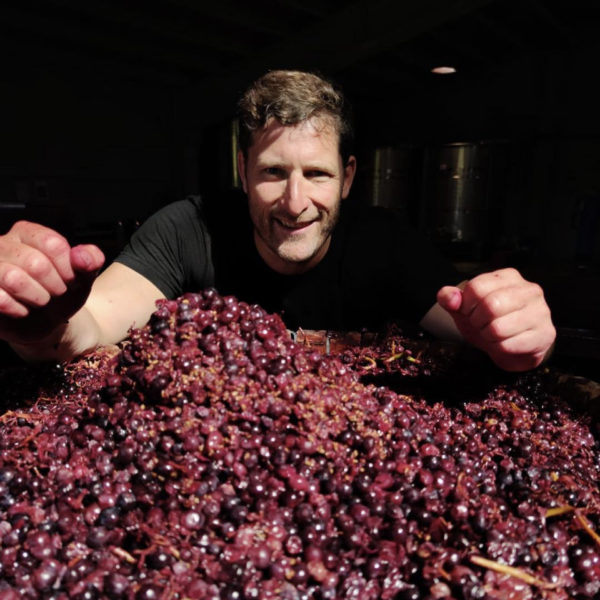
Terroir al Limit is one of Priorat’s most highly acclaimed wineries, established by Dominic Huber and Eben Sadie back in 2001. Sadie is no longer involved, but Huber has grown the project and is known for making terroir-sensitive wines that have a remarkable freshness and precision. I caught up with him and winemaker Tatjana Peceric to ask them more about what they are doing in this remarkable region.
Jamie Goode: What brought you to Priorat?
Huber: It was the idea of learning better Spanish. It was 25 years ago, in 1996. I arrived at the Mas Martinet winery to do a stage in winemaking, viticulture, and Spanish. This is quite funny because in Priorat they don’t speak Spanish, they speak Catalan. I found that out later!
Had you got any winemaking experience before that?
Huber: Not at all. I did a Master’s in business administration and marketing, and I realized that I didn’t want to end up in an office, but I wanted to work with my hands. I came from a family of butchers, so there was always food and wine, markets, and cooking. So I had a great sensibility to that. I became curious about wine and did my first wine classes in London. After that, I had the opportunity to go to Priorat because I knew the importer of Mas Martinet in Germany.
So you did the stage at Mas Martinet. What happened after that?
I finished my studies, but I was already so intrigued by the wine experience that once I had my masters, I went back to Spain to work a whole year with Mas Martinet, because I wanted to learn how to make wine. My father wasn’t pleased by this. During that year I met Eben Sadie, who was also at Mas Martinet.
Was Eben doing a stage there too?
Yes, it was a funny coincidence. I was very lucky because I met one of the best. I had a great combination with the Perez family at Mas Martinet (they are really great people) and on the other hand, I had an already-famous enologist and great character, Eben. It could only go well.
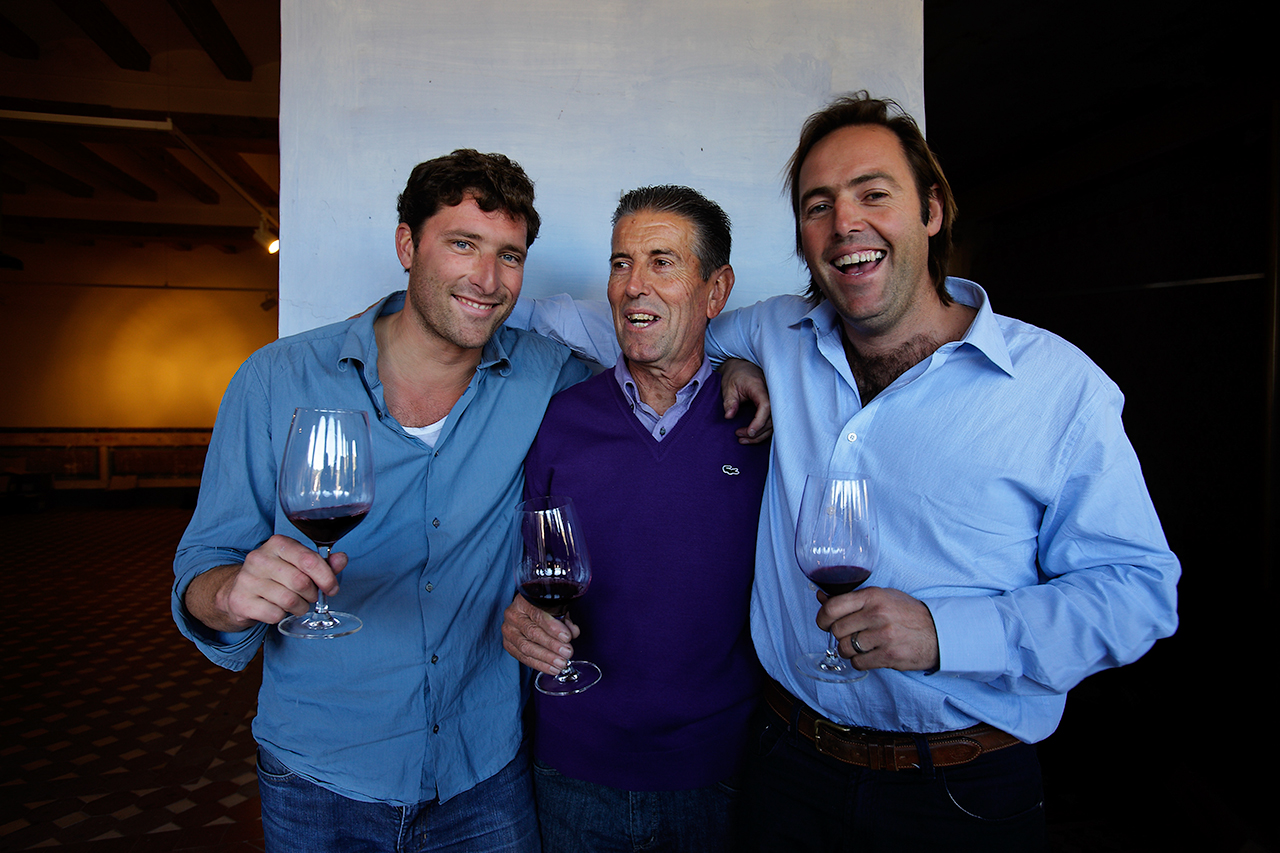
Dominik Huber, Jaume Sabate & Eben Sadie back in the day
Yes, 2000 was the first vintage of his Columella.
We started in 2001. We got some grapes from the Perez family, they were very generous with us. We were working at the Cooperativa of Cims de Porrera and we got some grapes from old vineyards. We made our first 300 bottles in 2001.
When I’ve tasted your wines I have always been struck by the style. They are beautifully terroir transparent, picked early. Were they fresh from the start like this?
Huber: We started making the wines in a more modern, international style, and now we are getting more and more extreme. Not by harvesting early, but by light extraction. We are doing infusion winemaking. We have also got rid of our oak: we just sold all our foudres. We had a whole wall of Stockinger that I bought for a lot of money a few years ago. We had good results from them, we were happy, but we were beginning to get annoyed by the aromatics of wood. Finally, we decided to sell our oak, and now we are 100% cement.
Stockinger foudres are highly sought after by people who are moving away from small oak to elevage in larger format. But I haven’t heard of many people moving away from Stockinger to go to cement or concrete.
Huber: We think our vineyards are of such a great quality and so beautiful in their character that we don’t want to have anything between the terroir and the glass.
Peceric: It wasn’t a sudden change. Since 2016 have already been producing Maynes and Arbossar only in cement. It was a gradual change, with a couple of years of experimenting, then bottling, just to see how the wines were with no oak. And then step by step we moved from oak. We sold all the foudres last year. The cement we bought was much more expensive than what we got for the foudres.
What did you buy? Nico Velo? Nomblot?
Peceric: We have a Nomblot, but we have started with a new company called CLC [CLC Vasche, which stands for Cooperative Lavorazione Cementi]. It’s an Italian company, and we do some different shapes and are trying new things. It is cement, and it’s not coated inside.
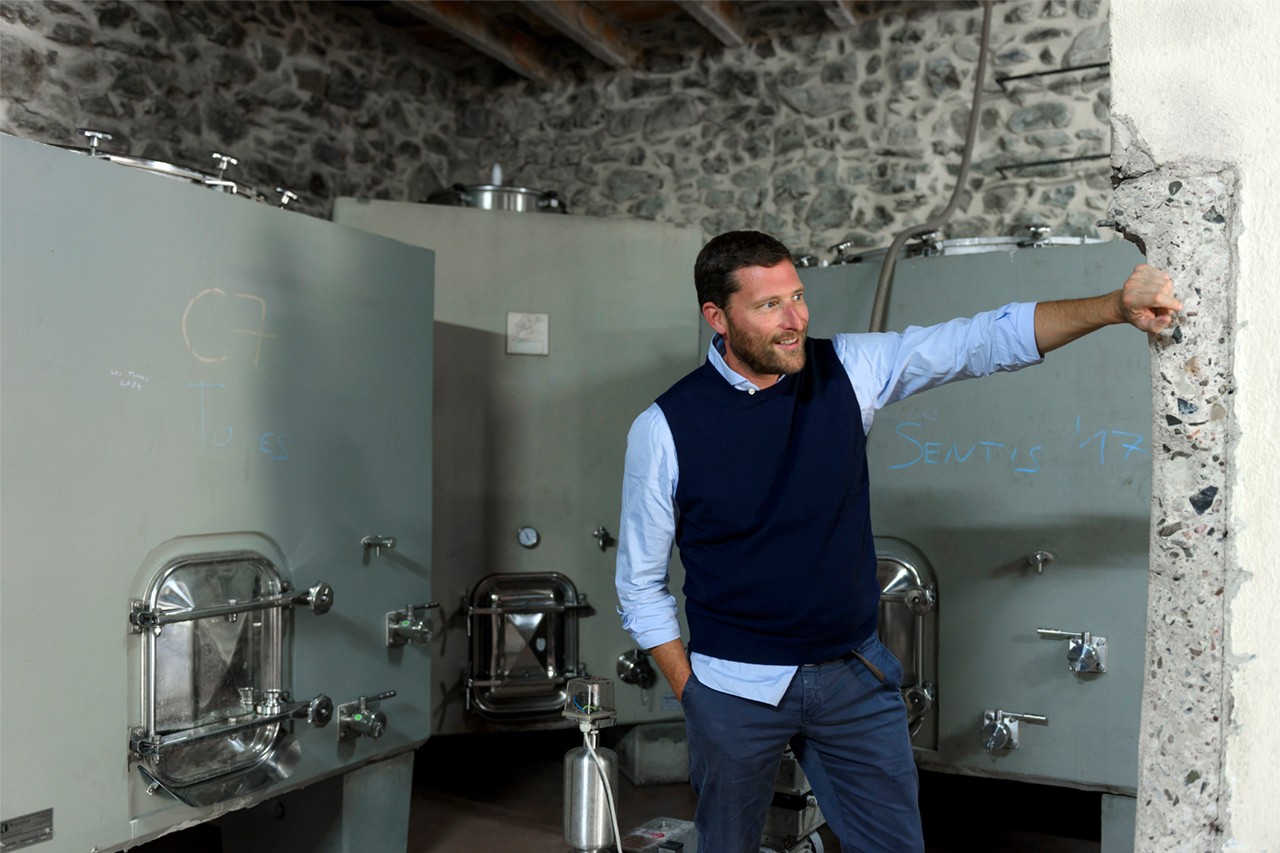
Do you think shape or the size of the cement makes a difference?
Peceric: Yes. It also depends on the size of your vineyard: if you have small plots you don’t need a big tank. We have different shapes. We are still experimenting and seeing what is best. We have a lot of square cement tanks open on the top for whole bunch fermentation, and these are good for aging too. Then we have ones that are more rounded.
What is the biggest advantage of cement? Is it thermal inertia? Is it neutral?
Huber: The most important thing is that it is really neutral. It is a great container. It is not stainless steel, which for me is a bit too aggressive. Stainless steel is good but it always feels a bit cold. Cement is neutral and the wine can breathe. We really like it: it respects the authenticity of the vineyard.
Tell me a bit about the Historic project.
Huber: Historic is a kind of democratic approach to Priorat. First of all, we want to turn Priorat into organic farming. That is super important to us. We are frustrated that Priorat is still mainly in the hands of chemical farmers that just want to do the easiest job and get the fastest money. We think the most important part of fine wine is organic farming, having respect for the land, and also towards the next generation. The second motivation is that we are passionate about food and gastronomy, but not only Michelin-starred places, but also the real places: the tapas bars and trattorias, the old lady that is doing something beautiful but simple. And we always miss the wine in those moments. There are great gastronomic moments but there is never a decent glass of wine you can drink with that food. We thought we’d like to make a wine that fits into those places: that is honest, true, and of high quality.
Are you making it in an old cooperative?
Huber: That was the original plan, but it didn’t work out because we realized that the cooperativa was surrounded by a village, and the village was unhappy about the idea of tractors and harvest noise. In the end, we decided that for the moment we will do it in our own cellar, and in the future, we want to build a bigger cellar, with a cellar for Terroir al Limit and a second cellar for Historic.
It’s from grape parcels that are farmed organically by other people?
Huber: Yes, we source the organic grapes from five families. But we just had a meeting today with a guy that owns a big piece of land in Porrera, up in the mountains, and he is converting to organics (he’s already organic but he’s just getting certified). The plan is that in two years we will have a certified organic Historic on the market. This will be a revolution in Priorat, having an inexpensive organic certified wine from a cool climate at 700 m altitude. It will be super light, low alcohol, really crisp wine.
Your farming is organic, but is much of the region still using herbicide?
Huber: To be honest, a big part of Priorat still uses herbicide. There are a few estates that farm organically, but the farmers who sell grapes are mostly using chemical products. It is a very difficult place to farm a kilo of grapes.
Do you own all the vineyards for Terroir al Limit?
Huber: All the wines for Terroir al Limit – village, premier cru, grand cru – are all from our own vineyards.
What are the different terroirs like?
Peceric: From the vineyards here around Torroja there aren’t many differences in the type of soil: it is all slate. But it differs in terms of how much quartz it has inside. The real differences are the inclination, the altitude, the exposition (north or south facing), which are extreme here and influence the grapes and in the end the wine. When we talk about Maynes, at high altitude on the mountain, the soil type is completely different. It is red clay: there is no slate. This is the big difference. But in the lower altitudes of Priorat up to 600 m it is mostly slate and different types of slate.
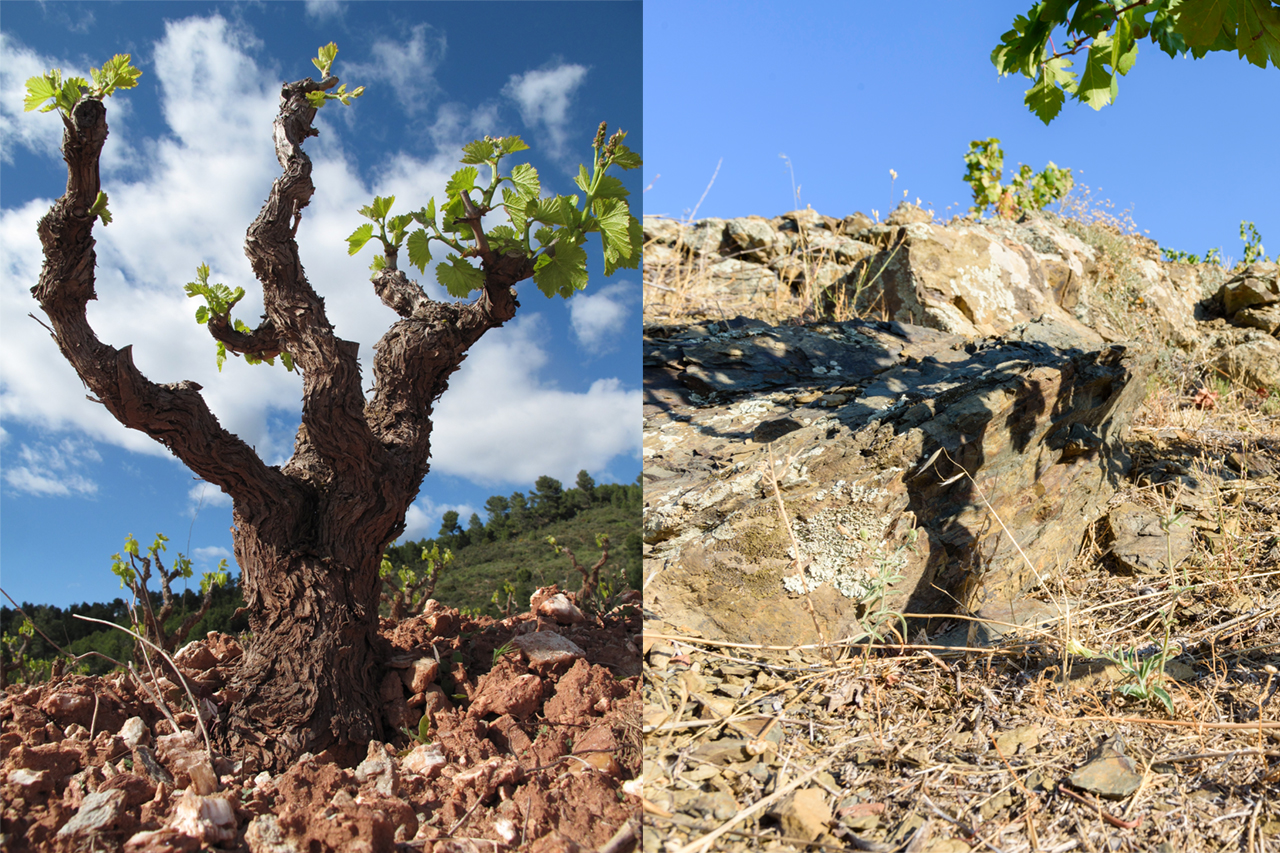
Manyes terroir of red clay and gypsum (left) and the sandy schist of Tosses (right)
What about grape varieties?
Peceric: We work mainly with local varieties, apart from one vineyard where we have to take some Syrah and Cabernet Franc. We work with Grenache (Grenache Noir and Garnacha Peluda) and Carignan. Peluda has hair on the leaves and ripens a bit later, and has good acidity and a better pH. It is a great grape variety.
Have you changed your approach to vinification? You say that you are using more of an infusion approach now.
Huber: We have been doing the infusion concept for quite a while. We are just refining it. I think we started in 2009 with whole cluster infusion winemaking. At the beginning there was a bit of pigeage; now we are not touching it. It depends on the quality of the vineyards. You can’t do this with second-class vineyards. You really need good vineyards with a lot of energy in the fruit, so you can leave the fruit without touching it, without punch downs or pump overs. We open the fermenters every day to check them, but we don’t touch them. You need to have a lot of experience to be able to do this. People are shocked when they come to work here and they see that nothing really happens. The big job is in the vineyard. I don’t say that the winemaking happens in the vineyard and in the cellar you do nothing: I think this is very stupid. It is like a chef: you can’t say that the dish is done when the fish comes out of the ocean. Of course, you have to respect the fish and treat it well; it is the same in the cellar. You need a specific vision of what you want to do, and you need a lot of discipline and character to make this happen in the cellar. It is a lot of discipline, a lot of cleaning, a lot of precision. Harvest is a very specific moment: it is beautiful, but it is also tiring. It is intense.
Peceric: You have to prepare constantly and really have a clear mind. You have to follow everything, know what is happening, and know what to do when something does happen.
What is a typical red wine fermentation for you? Presumably, you bring the grapes in small crates, then you have a sorting table. Is it mostly whole bunch?
Peceric: It’s 100% whole bunch fermentation, but it’s not that we aren’t doing anything. We tread the grapes, but very lightly. We don’t want to destroy the berries, but very slightly crush them. We want to make the layers even, to protect them from oxygen. We have some semi-carbonic maceration. We crush them very lightly, we don’t want to mash them. Every part of the tank has to be even. We add some CO2, and we also add some sulfites. We do everything naturally, but we use some sulfites, but this is gone by the end of the fermentation.
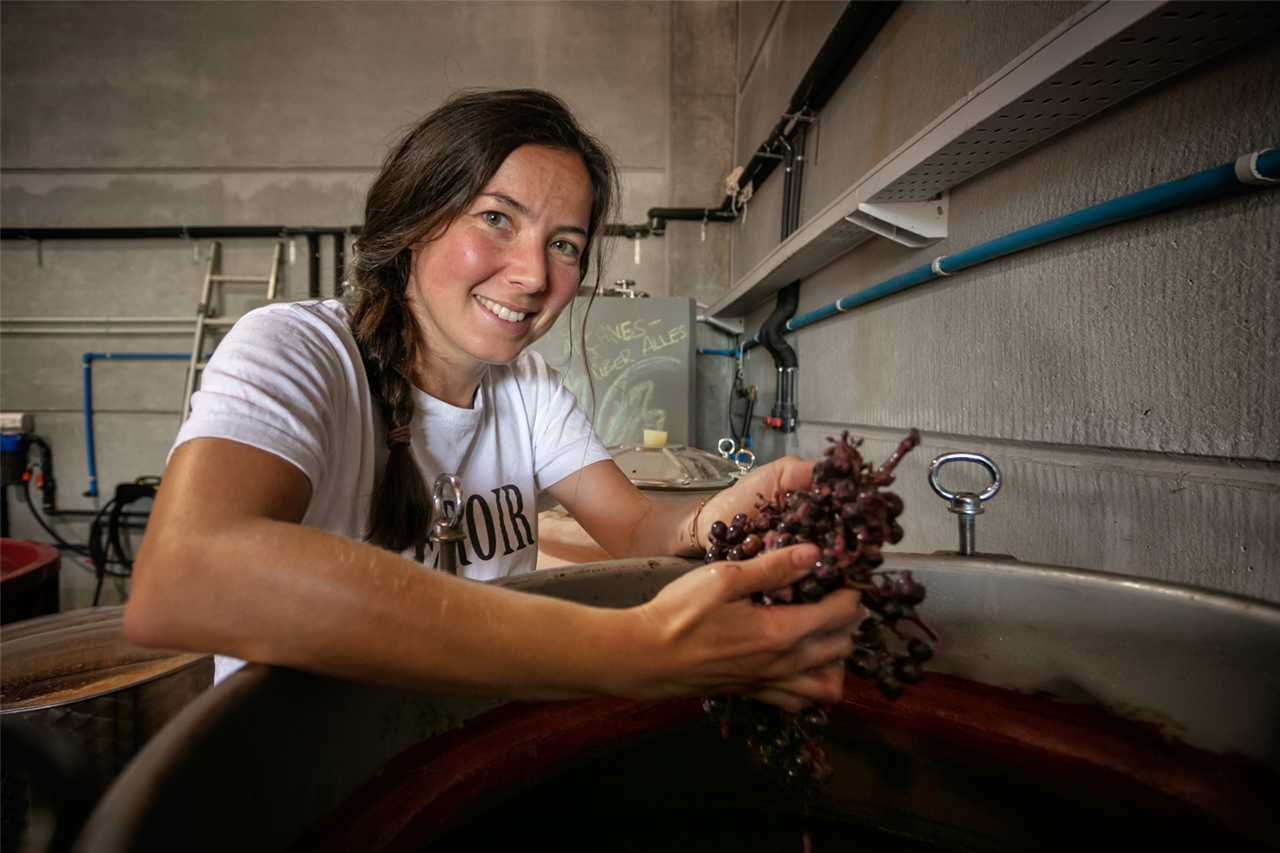
While the fermentation is taking place do you keep the cap wet?
Peceric: It depends. It is a decision made by experience and by the feeling. If it is necessary we do this. We might do some pumping over if the fermentation is getting a bit reductive.
Huber: We don’t want to be dogmatic about it. It’s important in fine winemaking that we don’t follow a recipe. We follow our feelings, and when we feel that there has to be some movement, then we get a bit of air to the tank.
Peceric: But very little. If it’s a big tank, 3000 liters, it would be like 5 minutes.
Do you press at dryness?
Peceric: No, we press at 8-12 days, and the fermentation will carry on for a couple of weeks more.
Huber: I think this is very important. I’m surprised that people don’t distinguish between continental and Mediterranean influence. In the Mediterranean, you harvest ripe tannins and you don’t need to get the tannins round. In Continental areas, you have tannin. We don’t have that: we have nice smooth tannins already. We have too much power and too much sun so we try to get rid of the skins at an early stage.
Are many other people in the region working the same way as you?
Huber: I think we are very unusual in this respect: the combination of low extraction, early harvest, and no oak. There is no one else that does this.
Peceric: Some people are trying to do a bit of whole bunch. People are not copying us, but they are trying this method.
Huber: You have to be intellectually very free to do what we do. If you are bound by culture or history or by market, you will be too afraid to do it. We have the market for this: we have people who follow what we do.
Has it been an easy journey, or has it been difficult because you are doing things in a different way?
Huber: I think it was very difficult. For me it was a difficult journey: it was hard to do something in Priorat which is a hard place with a closed society. Also, in the market, if you don’t make old school rather normal Priorat style, you have to explain a lot about what you are doing.
What size is the domain?
Huber: We own about 15 hectares that we work organically and biodynamically. We are already organically certified and we are now getting biodynamic certification.
What are the challenges working in Priorat?
Huber: From a business point of view, the challenge working in Priorat is that you have the DOC which is still on the intellectual status of 20 years ago – they don’t want to move a meter away from the historic approach. There is still Cabernet Sauvignon and Merlot, there is the small barrel, and big oaky alcoholic wines which they still see as a norm. When they tasted our wines they always said that they lacked typicity, so we had problems getting the OK from the DOC. The other thing is very practical: living in Priorat isn’t easy. It takes us at least 40 minutes to get to the next urban situation, and we need 1.5 hours to get to the airport and Barcelona city. When you are used to cultural life, and like nice restaurants, this is a tough reality.
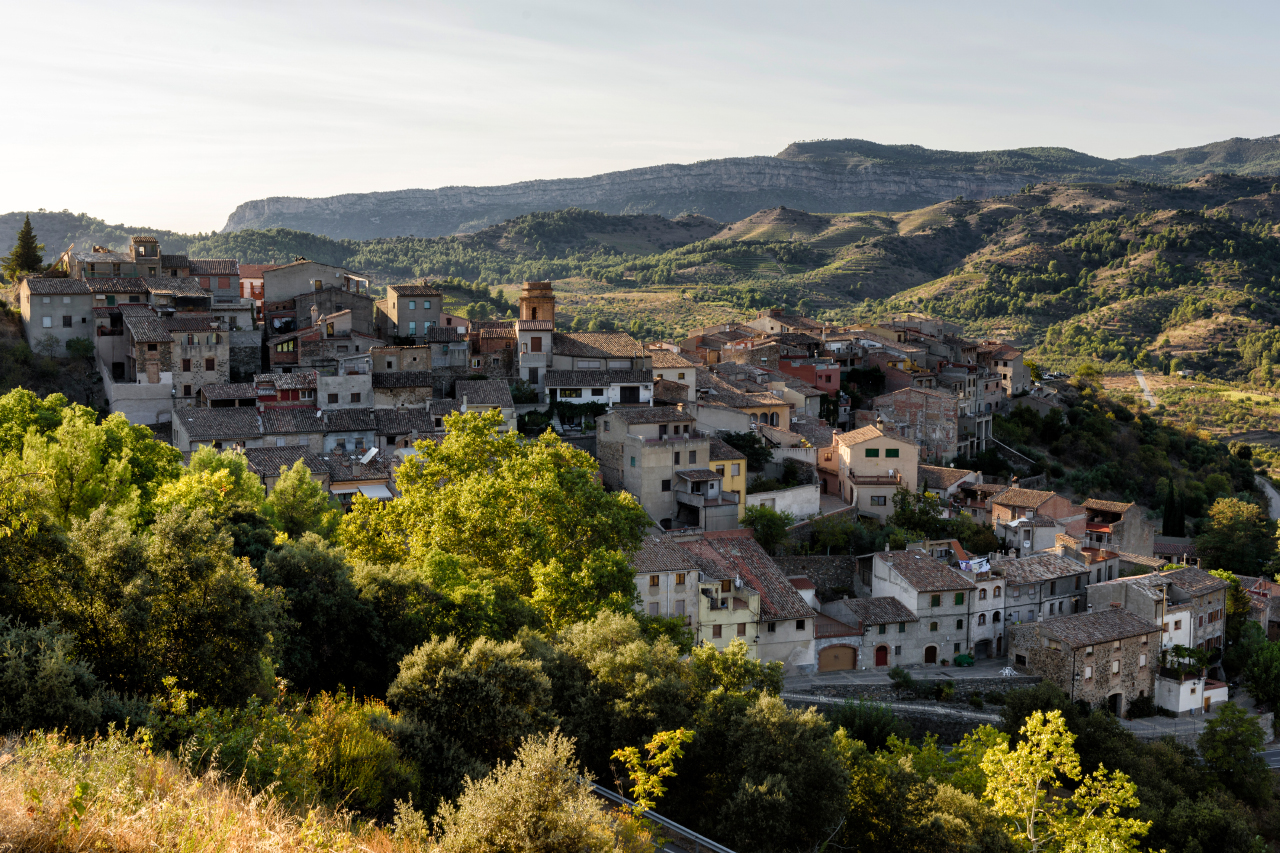
Torroja, population 148 (2018)
Do you have other winemaking projects?
Huber: I almost started making wine with Eben Sadie in Sicily. We already had the walking boots and the suitcase, and with Frank Cornelissen we wanted to buy a vineyard and start a project. The vineyard was not ripe enough, so we had to go back, and we realized we had so much work to do with Terroir al Limit we needed to focus on this. But we have started working in Montsant, and this is mainly Tatjana’s project.